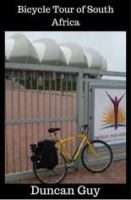
Photograph: Interesting road ahead
Anyone from the township outside Calitzdorp who had been indulging the night before, no matter what the substance, would have had to face the wrath of an aggressive-sounding sermon. It was playing on a public address system and audible for kilometres away at first light on the Sunday morning I left the “port capital”.
The dominee, or more likely the tape or disc on which he was recorded, rambled on and on. I could hear his voice loud and clear more than a kilometre after passing the township. It was easy to work out the distance I covered in the Western Cape. Large milestones, painted white, mark every kilometre.
The sermon was finally out of earshot when I reached the top of a hill where the two mountain ranges that had been on either side of me the day before seemed to have merged.
Then a glorious free wheel, down, down, down to the Gamka River. I was in a valley surrounded by enormous rock features, orange and brown in colour, much of them still waiting for sunrise to lighten them up.
This was the Huis River’s Pass.
For every downhill there had to be an uphill. Sure enough, that section of the pass awaited my attention as the day got warmer.
Engaging the lowest of all twenty-one gears on Mellow Yellow I made my way up, up, up the beautiful pass.
A troop of dassies dashed across the road ahead of me; at a lay-by where gums had been planted for shade, bees were busy in the blossom. I also had to avoid running over a small snake in the road. I thought it was dead until I saw its tongue flicker.
Then there was the sound of bells. Cattle with bells around their necks were grazing on the mountainside.
They were the first I had seen since emerging from the Homtini Pass when their dung mixed with the white, sandy mud from the road to spray paint my panniers.
COMMENT: Can you find out the scientific name for a dassie?
****
I was reminded once again of the water shortage in the area when I stopped at a small town called Zoar to stock up with water and eat one of those meat pies my body kept demanding whenever the opportunity to buy one arose.
A shop owner said I was welcome to fill my bottles from his tap and handed me what he called “the key”: the tap handle. The precious liquid was stored in a half-broken plastic tank that was only half-full. I made sure not to waste a drop.
From Zoar I could see Towerkop mountain, a beacon above the town of Ladismith, which was my destination on the day. The mountain had captured my imagination back at the Calitzdorp backpackers when I read about in Leon Nell’s book “The Garden Route and the Little Karoo: between the desert and the deep blue sea”.
Its summit was divided into two towers, the west and the east. I understood that the “tower” in its name related more to the Afrikaans word for “magic”.
According to Nel, there are “legends of witches trapped in the sheer cliffs and perpendicular overhangs of the western tower, howling unspeakable curses into the night”.
However, the story that grabbed me was of the first known ascent of the western tower by Gustav Nefdt, aged nineteen, back in 1886.
He had left his friends at the base of the tower and returned after an hour claiming to have reached the top. When he returned they would not believe him and he refused to repeat his climb but told them he had left a sock at the top, under a stone.
Back in town the young Gustav was also not believed and even became ostracised.
Months later he was part of another expedition, which he led to his sock, under the rock.
In later years, experienced mountaineers failed to reach the summit of the western tower. It was next conquered in 1947 by “a group with impressive climbing credentials and the best equipment money could buy”, according to Nell’s book.
COMMENT: How do you feel about Gustav having being ostracised?


